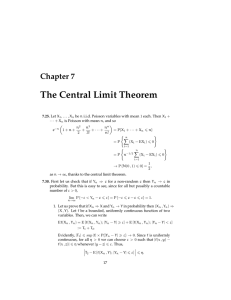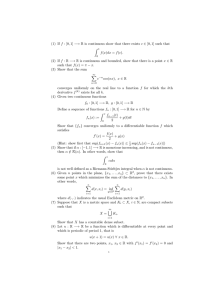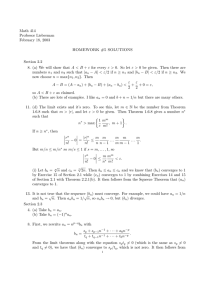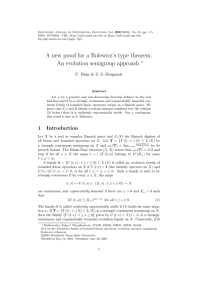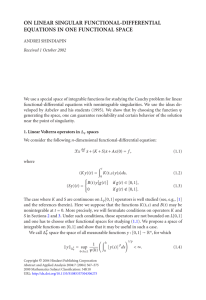18.100B Fall 2002 Homework 10 Solutions
advertisement
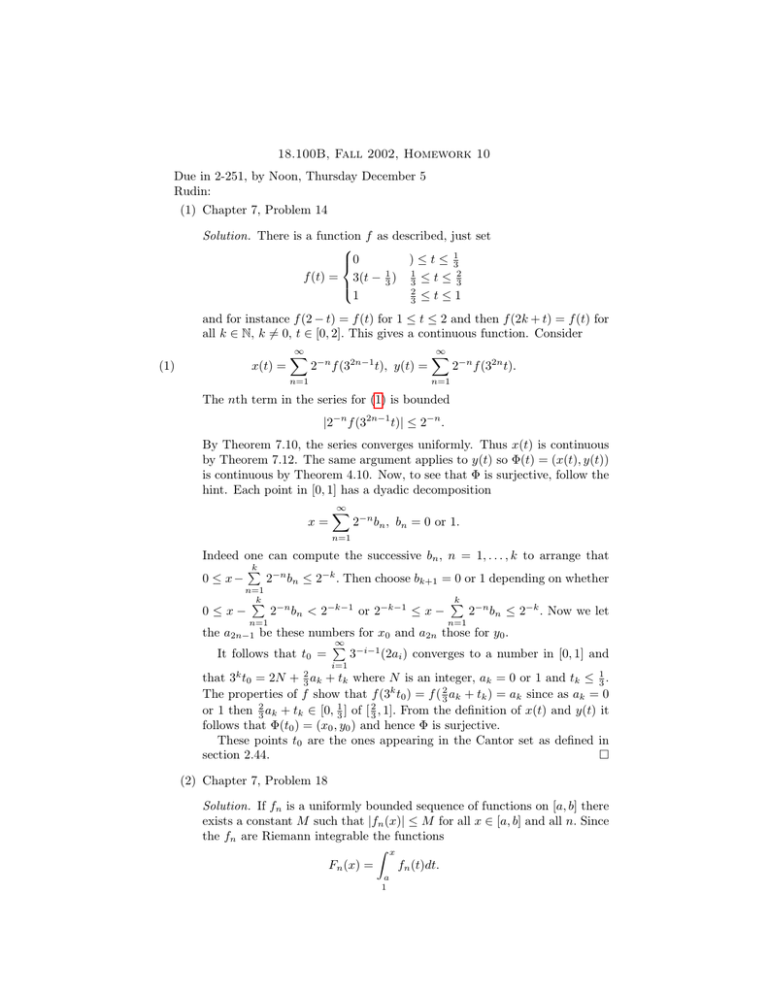
18.100B, Fall 2002, Homework 10
Due in 2-251, by Noon, Thursday December 5
Rudin:
(1) Chapter 7, Problem 14
Solution. There is a function f as described, just set
) ≤ t ≤ 13
0
f (t) = 3(t − 13 ) 13 ≤ t ≤ 23
2
1
3 ≤t≤1
and for instance f (2 − t) = f (t) for 1 ≤ t ≤ 2 and then f (2k + t) = f (t) for
all k ∈ N, k 6= 0, t ∈ [0, 2]. This gives a continuous function. Consider
(1)
x(t) =
∞
X
2−n f (32n−1 t), y(t) =
n=1
∞
X
2−n f (32n t).
n=1
The nth term in the series for (1) is bounded
|2−n f (32n−1 t)| ≤ 2−n .
By Theorem 7.10, the series converges uniformly. Thus x(t) is continuous
by Theorem 7.12. The same argument applies to y(t) so Φ(t) = (x(t), y(t))
is continuous by Theorem 4.10. Now, to see that Φ is surjective, follow the
hint. Each point in [0, 1] has a dyadic decomposition
x=
∞
X
2−n bn , bn = 0 or 1.
n=1
Indeed one can compute the successive bn , n = 1, . . . , k to arrange that
k
P
0 ≤ x−
2−n bn ≤ 2−k . Then choose bk+1 = 0 or 1 depending on whether
n=1
k
P
0 ≤ x−
the
2−n bn < 2−k−1 or 2−k−1 ≤ x −
n=1
a2n−1 be
k
P
2−n bn ≤ 2−k . Now we let
n=1
these numbers for x0 and a2n those for y0 .
∞
P
It follows that t0 =
3−i−1 (2ai ) converges to a number in [0, 1] and
i=1
that 3k t0 = 2N + 32 ak + tk where N is an integer, ak = 0 or 1 and tk ≤ 13 .
The properties of f show that f (3k t0 ) = f ( 23 ak + tk ) = ak since as ak = 0
or 1 then 23 ak + tk ∈ [0, 13 ] of [ 23 , 1]. From the definition of x(t) and y(t) it
follows that Φ(t0 ) = (x0 , y0 ) and hence Φ is surjective.
These points t0 are the ones appearing in the Cantor set as defined in
section 2.44.
(2) Chapter 7, Problem 18
Solution. If fn is a uniformly bounded sequence of functions on [a, b] there
exists a constant M such that |fn (x)| ≤ M for all x ∈ [a, b] and all n. Since
the fn are Riemann integrable the functions
Z x
Fn (x) =
fn (t)dt.
a
1
2
are continuous. We show that the sequence Fn is equicontinuous. In fact
if x ≤ x0 ∈ [a, b] then
Z x0
|Fn (x) − Fn (x0 )| ≤
|fn (t)|dt ≤ M |x − x0 |.
x
0
Thus, if |x − x | < δ = /M then |Fn (x) − Fn (x0 )| < , showing the equicontinuity. We also have a uniform bound |Fn (x)| ≤ (b − a)M. As a sequence
of uniformly bounded and equicontinuous functions on a compact metric
space we see from Theorem 7.25 that {Fn } has a uniformly convergent
subsequence.
(3) Chapter 7, Problem 24
Solution. We define a map X −→ C(X) into the space of bounded continuous functions on X. Fixing a point a ∈ X let
f : X 3 p 7−→ fp , fp (x) = d(x, p) − d(x, a).
By the triangle inequality d(x, p) ≤ d(x, a) + d(a, p) and d(x, a) ≤ d(x, p) +
d(a, p) shows that |fp (x)| ≤ d(a, p). Thus fp is a bounded function. It is
continuous, again by the triangle inequality
|fp (x) − fp (y)| ≤ |d(x, p) − d(y, p)| + |d(x, a) − d(y, a)| ≤ 2d(x, y).
Thus fp ∈ C(X). Now, consider
kfp (x) − fq (x)k = sup |d(x, p) − d(x, a) − d(x, q) + d(x, a)|
x∈X
= sup |d(x, p) − d(x, q)| = d(p, q).
x∈X
The last inequality follows from the triangle inequality and the fact that
fp (q) − fq (q) = d(p, q).
It follows that f is a continuous map. It is an isometry, namely the
distance in C(X) is kf − gk. In particular this shows that f is 1-1. Let Y
be the closure of f (X) ⊂ C(X). Then we may regard X ⊂ Y using f. As a
closed subset of C(X), Y is complete as a metric space. Thus X is isometric
to a subset of the complete space Y in which it is dense.
(4) Chapter 5, Problem 26
Solution. We assume that f is differentiable on [a, b], f (a) = 0 and there is
a real number A such that |f 0 (x)| ≤ A|f (x)| for all x ∈ [a, b]. Following the
hint, for a chosen x0 ∈ (a, b], set M0 = sup |f (x)| and M1 = sup |f 0 (x)| with
the suprema over [a, x0 ]; where the second exists because of the assumption.
It follows that M1 ≤ AM0 . By the mean value theorem f (x) − f (a) =
f 0 (y)(x − a) for some y ∈ (a, x0 ) so
|f (x) − f (a)| = |f (x)| = |f 0 (y)||x − a| ≤ M1 (xa ) ≤ AM0 (x0 − a).
Taking the sup over x ∈ [a, x0 ] we see that M0 ≤ AM0 (x0 − a). Taking
x0 − a so small that A(x0 − a) < 1 we see M0 ≤ 0 and hence M0 = 0. Thus
f (x) = 0 on [a, x0 ]. Set z = sup{x0 ; f (x) = 0 on [a, x0 ]}. If z = b we are
finished, since f is continuous so f (z) = 0. If z < b then we may apply the
argument again to find a contradiction.
(5) Chapter 5, Problem 27
3
Solution. I did this in class in a slightly different way, so I am just asking
you to write down the proof. Namely if fi (x) are two solutions, for i = 1, 2,
then we may integrate the equation to see that
Z x
fi (x) = c +
φ(t, fi (t))dt.
a
It follows that the difference f (x) = f2 (x) − f1 (x) satifies
f (a) = 0, f 0 (x) = φ(x, f1 (x)) − φ(x, f2 (x).
(2)
We see that |f 0 (x)| ≤ A|f (x)| where A is the constant in the Lipschitz
condition. Applying the previous problem, we conclude that f = 0.
1
Differentiating y = 14 x2 , y 0 = 12 x = y 2 shows that it is a solution in
[0, 1]. Thus both y ≡ 0 and y = 14 x2 are both solutions.
These are not the only solutions, since if x0 > 0 and we define
(
0
x < x0
y= 1
2
(x
−
x
)
x ≥ x0
0
4
we get a continuously differentiable solution by the same argument. Con1
versely every solution, y ≥ 0, of y 0 = y 2 is of this form. Indeed, if y(t) > 0
for some t ∈ (0, 1) then, being continuous,
is positive nearby. Thus we
it1 1
d
−
can divide by y 2 and conclude that dx 2y 2 = 1 on any interval where
1
y > 0. This implies that 2y − 2 = x − x0 for some constant x0 and hence
that (2) holds in any interval where y > 0. In principle there could be different values of x0 on different intervals. However, y in (2) is increasing,
so the set on which it is strictly positive must be of the form (x0 , 1] for
some x0 ∈ [0, 1], since y(0) = 0. Thus the general solution is (2) for some
x0 ∈ [0, 1].
PS. I don’t have the book with me, perhaps the upper limit of the interval
here is ∞, but the argument is the same.
